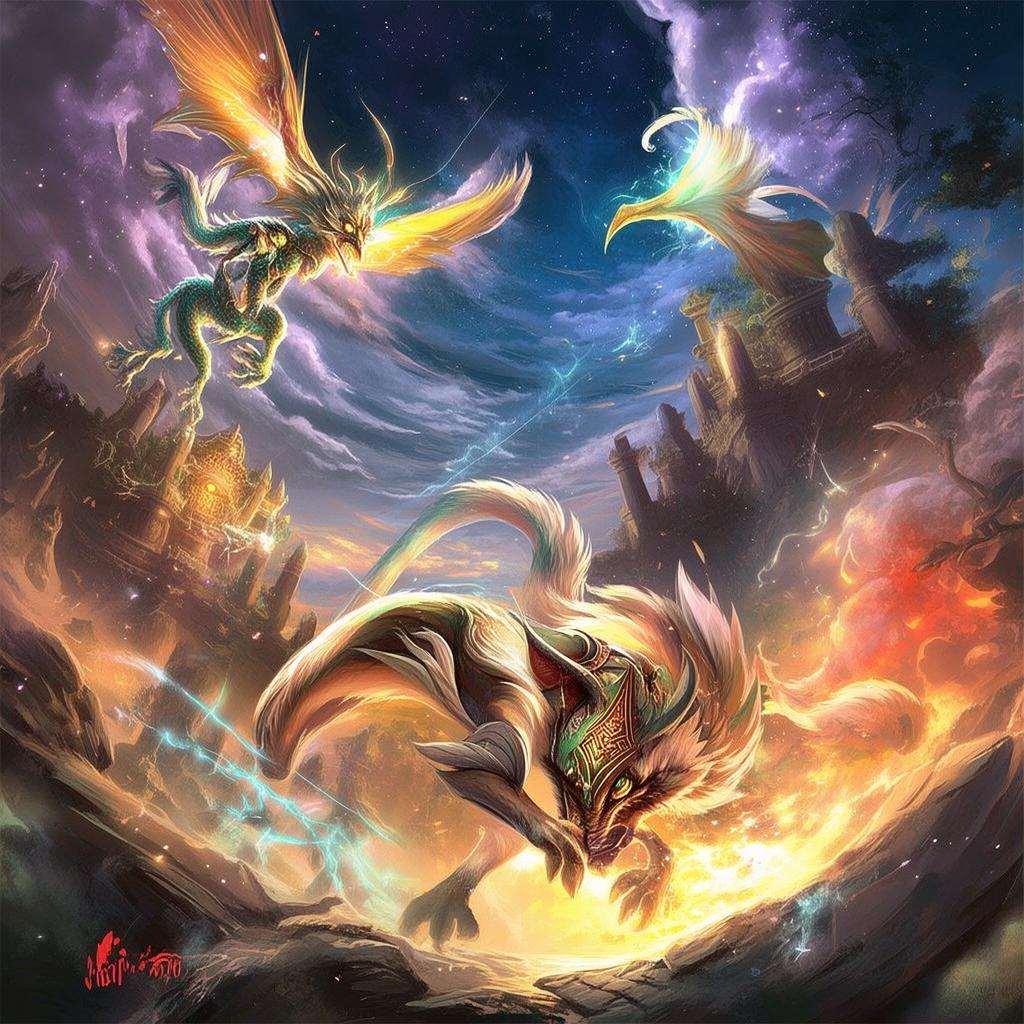The White Deer's Lament: A Journey Through the Endless Abyss
In the ancient lands of China, where mountains rose like the backbones of the earth and seas whispered ancient secrets, there lived a white deer, an animal of great purity and grace. The deer's fur was as white as snow, and its eyes, a piercing blue that seemed to see beyond the veil of reality. The people of these lands spoke of the white deer with reverence, for it was said that it could sense the very pulse of the world, and its presence was a sign of great change.
One fateful day, as the sun dipped below the horizon and painted the sky in hues of orange and crimson, the white deer felt an inexplicable pull—a call to journey to the end of the world. This was no ordinary journey; it was a quest to uncover the mysteries of the ancient Chinese landscape as recorded in the legendary text, the "Shan Hai Jing" or "Classic of Mountains and Seas."

The white deer set out with nothing but its determination and the knowledge that it was bound to face the most perilous of creatures. The first leg of its journey led it through the "Lao Mountain," a place where the sky was perpetually shrouded in mist and the earth trembled with ancient energies. Here, the deer encountered the "Lao She," a massive, serpentine creature that slithered through the mountains, its scales shimmering with a thousand colors. The Lao She was the guardian of the mountain, and it demanded the deer offer a sacrifice to pass.
The white deer, knowing that the sacrifice must be pure, offered its own fur, which was as white as the snow and as precious as the mountain itself. The Lao She was moved by the deer's selfless act and allowed it to pass. From there, the journey led the deer through the "Yin and Yang Forest," where the trees were said to be alive with the spirits of the dead. The deer had to navigate through the dense thicket, guided only by the soft glow of bioluminescent flowers that lit its path.
As the deer pressed on, it encountered the "Bai Tu," a white tiger with eyes like flames, whose roar could shake the very mountains. The Bai Tu was a fearsome creature, but the white deer, with its pure heart, approached it with respect and humility. The Bai Tu, recognizing the deer's purity, revealed the second part of its journey, which was to seek the "Heavenly Spring," a sacred place where the waters were said to possess the power to grant immortality.
The deer's journey was fraught with trials, each more difficult than the last. It crossed the "Misty Sea," where the waters were so deep and dark that no light could penetrate. The deer swam through the depths, guided by the bioluminescent creatures that lived within the sea. Finally, it reached the "Heavenly Spring," where the waters were clear and cold, and the air was filled with the song of the phoenix.
The white deer drank from the spring, feeling a surge of energy course through its veins. But just as it felt the power of immortality, a figure emerged from the mist, a sorcerer who had been waiting for the deer's arrival. The sorcerer revealed that the "Heavenly Spring" was a trap, and the white deer's sacrifice was to be his own life force. The deer, with its newfound power, fought back, and in a fierce battle, it triumphed over the sorcerer.
With the sorcerer defeated, the white deer continued its journey, seeking the end of the world. It reached the "Endless Abyss," a place where the earth ended and the sky began. The deer, looking out into the void, realized that the true end of the world was not a physical place, but the edge of one's own existence. It was a place where the boundaries between life and death, reality and fantasy, blurred into one.
The white deer, having completed its journey, returned to the land of its birth, forever changed by its experiences. It shared the wisdom it had gained, and the tale of its journey was recorded in the "Shan Hai Jing," a testament to the power of determination and the enduring nature of myth.
As the sun rose again, painting the sky in hues of gold and pink, the white deer stood at the edge of the world, its eyes glistening with the light of ancient secrets. It knew that its journey was not over, but rather, it had just begun. And so, the white deer's tale lived on, a beacon of hope and wonder in the ancient Chinese landscape.
✨ Original Statement ✨
All articles published on this website (including but not limited to text, images, videos, and other content) are original or authorized for reposting and are protected by relevant laws. Without the explicit written permission of this website, no individual or organization may copy, modify, repost, or use the content for commercial purposes.
If you need to quote or cooperate, please contact this site for authorization. We reserve the right to pursue legal responsibility for any unauthorized use.
Hereby declared.









